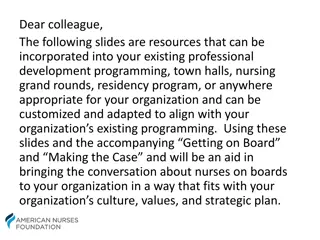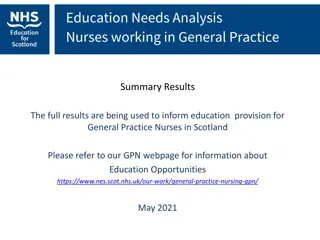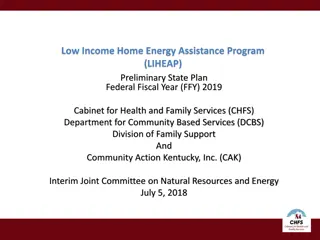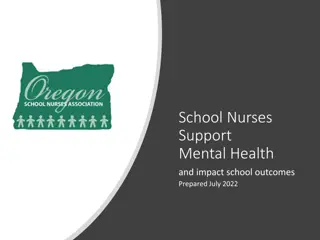Addressing the School Health Crisis in Kentucky: The Urgent Need for More School Nurses
Kentucky is facing challenges in school health, with low numbers of school nurses and poor health indicators among children. The inadequate nurse-student ratio and lack of consistency in providing health services are major concerns. Research emphasizes the critical role of school nurses in promoting healthy behaviors and improving academic, physical, and mental health outcomes. To address this crisis, Kentucky must prioritize increasing the number of school nurses to ensure better health outcomes for its students.
Download Presentation

Please find below an Image/Link to download the presentation.
The content on the website is provided AS IS for your information and personal use only. It may not be sold, licensed, or shared on other websites without obtaining consent from the author.If you encounter any issues during the download, it is possible that the publisher has removed the file from their server.
You are allowed to download the files provided on this website for personal or commercial use, subject to the condition that they are used lawfully. All files are the property of their respective owners.
The content on the website is provided AS IS for your information and personal use only. It may not be sold, licensed, or shared on other websites without obtaining consent from the author.
E N D
Presentation Transcript
Kentucky School Nurse Initiative Kentucky School Nurse Initiative Interim Joint Committee on Education Interim Joint Committee on Education October 20, 2020 October 20, 2020 Gannon Gannon Tagher Tagher, , Ed.D Ed.D., MSN, RN, APRN ., MSN, RN, APRN Every School Needs A Nurse Every Day, All Day!
Healthy Children Build Healthy Communities Researchers state that second only to home, school represents the most influential environment in a child s life School nurses promote and support healthy behaviors by being a part of every school community, resulting in positive outcomes: Leads to healthy outcomes Academic Physical Psychosocial Mental Health A child s ability to learn is directly related to health status
What is the Problem? Kentucky is in the bottom 10 states in the nation for multiple health indicators in children: Physical health Mental health Diabetes Asthma Obesity Oral Health Substance Use Kentucky has a high rate of children with special needs Sixteen percent of children in Kentucky live in high poverty areas From 2016 to 2019, the rate of uninsured children in Kentucky increased by 29%
What is the Problem? Inconsistency among school districts in how school health services are provided The National Association of School Nurses recommends a minimum of one nurse for every 750 students This ratio is also supported by the American Academy of Pediatrics (AAP) Forty-three percent of schools in KY do not meet this nurse-student ratio In the 2018-19 academic year, 31% of public-school districts in KY did not hire or contract for nursing services There are 669,449 students in KY that attend public school In 2018-2019, there were 1466 public schools in KY with only 869 nurses reported
Principles to Improve the Health of All Children (AAP, 2016) School Nurses improve the health, wellbeing and safety of both children and adolescents Impact both individual and population health Daily access to students allows for coordination of students healthcare needs School nurses can address the impacts of social determinants of health Economic Stability Education Health and Healthcare Neighborhood and Built Environment Social and Community Context
Principles to Improve the Health of All Children School Nurses work with physicians to keep children in their medical home Educate about normal development Promote health and safety Intervene with actual/potential health problems Provide care coordination services Manage children with disabilities and chronic illnesses School Nurses improve public health Immunizations Obesity prevention Substance use assessment Tobacco control Asthma education
Preventing/Identifying Adverse Childhood Events (ACES) ACES are potentially traumatic events that occur during childhood Abuse Neglect Experiencing violence Home instability Impact of ACES Obesity Diabetes Depression STDs Heart disease Smoking, alcoholism, drug use Decreased educational achievement
Coordinated School Health The National School Superintendent s Association endorses coordinated school health Healthy students are better learners The link between health and schools has become more important during the COVID-19 pandemic Establishing healthy behaviors in childhood is more effective than trying to change behaviors in adulthood Schools play a critical role in promoting health Improved health leads to increased academic success
Keeping Kids Safe In 2018-2019 the following were reported 21,074 children with food allergies 47,805 children with asthma 1, 507 children with Type I diabetes Without a school nurse in the school all day, there could be significant safety concerns for the health of these children. A school nurse can prevent health emergencies and save lives
Role in Covid-19 What are School Nurses Doing? Health Resource Expert Answering questions from parents and communities Virtual office hours Screening of staff and visitors Education Infection control measures Disseminating health department updates Community education Creating videos on Covid-19 Student Outreach Identifying students at risk Assist with deliveries of medication and food
Role in Covid-19 What are School Nurses Doing? Chronic Condition Management Assisting students with chronic conditions Working on student healthcare plans Medication and equipment return to families Update Policies and Plans Developing and revising school health policies Updating/developing plan to return to school Evaluating resources for re-opening Data collection re: Covid 19 testing and contact tracing
School Violence Prevention Promote the prevention and reduction of school violence Implement evidence-based programs promoting violence prevention Recognize factors that increase risk of a student becoming a perpetrator or victim of school violence Bullying Mental health crisis Physical assault Student on student violence Student on staff violence Staff on student violence Escalating violence/violent intruder
School Violence Prevention Help create a protective community environment through a multi- disciplinary team approach to violence prevention Serve on school safety and curriculum committees Collaborate with social work, counseling, and law enforcement to maintain security Assist in the development of district policy Facilitate partnerships between the school and local healthcare agencies If violence occurs: Coordinate emergency response Provide nursing care to injured Apply crisis intervention strategies to de-escalate the situation
SB 1 - School Safety Act (2019 GA) Established a "Trauma-informed approach , as recommended by the federal Substance Abuse and Mental Health Services Administration, in a school in order to foster a safe, stable, and understanding learning environment for all students and staff and ensuring that all students are known well by at least one (1) adult in the school setting. The General Assembly recognizes that all schools must provide a place for students to feel safe and supported to learn throughout the school day, and that any trauma a student may have experienced can have a significant impact on the ability of a student to learn. The General Assembly directs all public schools to adopt a trauma-informed approach to education in order to better recognize, understand, and address the learning needs of students impacted by trauma and to foster a learning environment where all students, including those who have been traumatized, can be safe, successful, and known well by at least one (1) adult in the school setting. The trauma-informed team may consist of school administrators, school counselors, school-based mental health services providers, family resource and youth services coordinators, school nurses, and any other school or district personnel.
Safe and Supportive Schools The National Parent-Teacher Association (PTA) issued a Position Statement on Safe and Supportive Schools in 2018 Under the Topic of School Climate and Student Support Services, the Statement Said This: Promote a positive school climate that encourages nurturing relationships, and mutual trust and respect among students, staff and families. Improve staffing ratios of school counselors, school psychologists, school social workers, and school nurses to provide school-based behavior, health and mental health services
TheSolution: A School Nurse in Every School All Day Every Day
Schools With Nurses Have Improved attendance rates with lower absenteeism Higher high school graduation rates Higher standardized test scores Decreased use of local emergency department services Reduced transmission of infectious diseases Positive outcomes related to COVID-19
Schools With Nurses Have Earlier diagnosis and treatment of problems physical, psychosocial, and academic Management of chronic childhood conditions e.g., asthma, diabetes, cystic fibrosis, seizures Assessment and referral of students with substance use Screening, individual assessment and referral of students with poor physical or mental health
Schools With Nurses Have Promotion of health and wellness programs Management of teasing and bullying resulting in decreased child anxiety and concentration problems Decreased absenteeism or early dismissal with PT nurses vs school staff Further decreased absenteeism or early dismissal with FT nurses vs PT nurses A safe place for students to share confidential information and concerns about themselves or others in the school community
Achieving the Solution How Can School Nurses be Funded?
How Can School Nurses be Funded? Reversal of the Medicaid Free Care Rule The Bevin Administration announced in November of 2019 that their Medicaid state plan amendment to expand health services in schools had received final approval from CMS. Historically, schools were only able to bill Medicaid if the services were outlined in a student s Individualized Education Plan (IEP). Health and mental health services provided to children at school without an IEP were not billable. The Medicaid state plan amendment will allow school districts to use federal funding to expand access to physical and mental health services like health screenings, immunizations, nursing services, speech therapy and mental health counseling for students enrolled in Medicaid. This will be especially helpful to school districts as they work to meet the requirements in SB 1, the School Safety Bill, passed after the Marshall County High School shooting. Schools can bill for services that are medically necessary , which includes services performed by school nurses. This change is particularly beneficial for schools with high free/reduced lunch numbers, which correlates with Medicaid eligibility.
How Can School Nurses be Funded? Partnerships with Community Agencies Some school districts currently have contractual relationships in place with community agencies to fund school nurses. The school district contributes funds and the community agencies contribute funds. This is a win-win relationship: community agencies address quality and outreach, while the schools receive the services of a school nurses. Examples of models include (but are not limited to): Local health departments Federally qualified health centers Local hospital systems
How Can School Nurses be Funded? Utilizing Every Student Succeeds Act Funding Having a school nurse in the school can impact student health and learning by focusing on reducing chronic absenteeism with programs of early prevention and intervention with health conditions. Chronic absenteeism is defined as a student missing 10% or more of school for any reason (excused or unexcused absences). Under Kentucky s Every Student Succeeds Act (ESSA) Plan, Title I, II, and IV funds Part A can be utilized to fund a nurse in the school. https://www2.ed.gov/policy/elsec/guid/eseatitleiswguidance.pdf https://neusha.org/student/programs/attachments/ESSANASN.pdf
How Can School Nurses be Funded? Allocation of Funding in State s Budget, Beginning with a Pilot Project As a working model, we assume an annual salary for a school nurse of $52,406 (which includes 30% calculated for benefits), using a 43-week school year and 37.5 hrs/week. This salary, multiplied by 1,233 schools in Kentucky, would cost approximately $65M to add a nurse for each school, every day, all day. Considering the total school population of 670,000 students, this amounts to approximately $96/student. If the upcoming budget were to allocate $3M toward the school nurse initiative, 56 school nurses could be hired in a pilot project and placed in districts with the greatest need for school nurse services. Data would be gathered to measure the impact of adding school nurses in these schools. *The above calculations do not reflect a school district s ability to contract or share a model of collaboration with outside agencies (e.g., Local Health Departments). **The Reversal of the Medicaid Free Care Rule would assist School Districts in utilizing Medicaid billing for school nurse service, thus maximizing financial resources.
References See Word Document
Questions? Contact me at tagherc1@nku.edu























